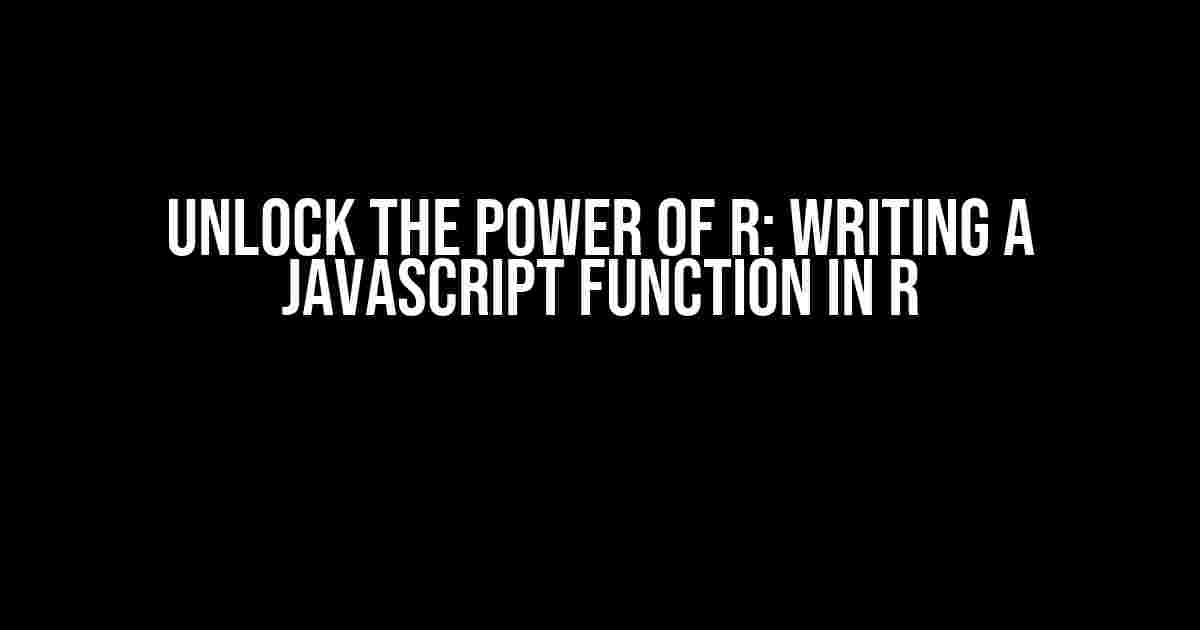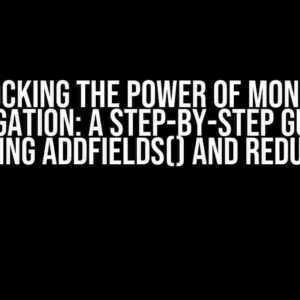Are you an R enthusiast looking to tap into the world of Javascript? Do you want to supercharge your R skills by combining the two languages? Look no further! In this comprehensive guide, we’ll show you how to write a Javascript function in R, unlocking a world of possibilities for data analysis, visualization, and more.
Why Javascript in R?
Before we dive into the nitty-gritty, let’s talk about why you’d want to write a Javascript function in R in the first place. The reasons are plenty:
- Data Visualization**: R provides an incredible range of data visualization libraries, but sometimes you need more interactivity. Javascript can help you create dynamic, web-based visualizations that will leave your audience in awe.
- Web Scraping**: R’s web scraping capabilities are impressive, but with Javascript, you can scrape data from websites that use complex, dynamic loading mechanisms.
- Interactive Dashboards**: Create interactive dashboards that update in real-time with R and Javascript, giving your stakeholders a seamless experience.
- Machine Learning**: Leverage R’s machine learning prowess and Javascript’s ability to handle complex UI/UX tasks, creating a powerful Machine Learning workflow.
Getting Started with R and Javascript
Before we write our first Javascript function in R, let’s cover the basics:
Installing Required Libraries
You’ll need two essential libraries to get started: htmlwidgets and crosstalk. These libraries provide the necessary infrastructure for integrating R and Javascript:
# Install required libraries
install.packages("htmlwidgets")
install.packages("crosstalk")
Loading Libraries and Setting Up Rmarkdown
Load the required libraries and set up your Rmarkdown environment:
# Load required libraries
library(htmlwidgets)
library(crosstalk)
# Set up Rmarkdown environment
library(rmarkdown)
Writing Your First Javascript Function in R
It’s time to write our first Javascript function in R! We’ll create a simple function that takes a string input and returns it in uppercase:
# Create a new Rmarkdown document
---
title: "My First Javascript Function in R"
output: html_document
---
```{r, results="asis"}
# Load required libraries
library(htmlwidgets)
# Create a Javascript function
js_code <- '
function uppercase(str) {
return str.toUpperCase();
}
'
# Create an htmlwidget with the Javascript function
htmlwidget::JS(js_code) %>%
htmlwidgets::htmlDependency("https://cdnjs.cloudflare.com/ajax/libs/jquery/3.4.1/jquery.min.js") %>%
htmlwidgets::htmlDependency("https://cdn.jsdelivr.net/npm/@@[email protected]/dist/handsontable.full.min.js")
```
Let’s break down what’s happening here:
- We create a new Rmarkdown document with an HTML output.
- We load the
htmlwidgetslibrary, which provides the infrastructure for integrating R and Javascript. - We define our Javascript function, which takes a string input and returns it in uppercase.
- We create an htmlwidget with the Javascript function using the
JS()function. - We add dependencies for jQuery and Handsontable, libraries that will help us create interactive web-based visualizations.
Calling the Javascript Function from R
Now that we have our Javascript function, let’s call it from R:
```{r}
# Call the Javascript function
input_str <- "hello world"
output_str <- JS("uppercase")(input_str)
cat(output_str)
```
Run the code, and you should see the output:
HELLO WORLD
Advanced Topics: Integrating R and Javascript
Now that we've covered the basics, let's dive into some advanced topics:
Passing R Data to Javascript
How do we pass R data to our Javascript function? We can use the jsonlite package to convert R data to JSON, which can then be passed to our Javascript function:
```{r}
# Load the jsonlite library
library(jsonlite)
# Create a sample dataset
df <- data.frame(x = 1:5, y = 6:10)
# Convert the dataset to JSON
json_data <- toJSON(df, pretty = TRUE)
# Pass the JSON data to the Javascript function
js_code <- '
function process_data(data) {
console.log(data);
}
'
JS(js_code)(json_data)
```
Returning Data from Javascript to R
How do we return data from our Javascript function to R? We can use the htmlwidgets::JS() function to call our Javascript function and retrieve the result:
```{r}
# Create a sample Javascript function
js_code <- '
function double_value(x) {
return x * 2;
}
'
# Call the Javascript function and retrieve the result
result <- JS(js_code)(5)
cat(result)
```
Real-World Applications: Creating an Interactive Dashboard
Let's create a real-world application: an interactive dashboard that updates in real-time using R and Javascript:
```{r}
# Load required libraries
library(shiny)
library(htmlwidgets)
library(crosstalk)
# Create a sample dataset
df <- data.frame(x = 1:5, y = 6:10)
# Create an interactive dashboard
ui <- fluidPage(
htmlwidget("scatter_plot", "Scatter Plot"),
actionButton("update_button", "Update Plot")
)
server <- function(input, output) {
# Create a reactive expression for the scatter plot
scatter_plot <- eventReactive(input$update_button, {
# Update the dataset
df <- data.frame(x = 1:10, y = 11:20)
# Create a scatter plot using Handsontable
scatter_plot <- JS("scatter_plot_function")(df)
scatter_plot
})
# Render the scatter plot
output$scatter_plot <- renderUI({
scatter_plot()
})
}
# Create the Javascript function for the scatter plot
scatter_plot_function <- '
function scatter_plot_function(data) {
// Create a scatter plot using Handsontable
var hot = new Handsontable(document.getElementById("scatter_plot"), {
data: data,
colHeaders: ["X", "Y"],
rowHeaders: true,
fillHandle: "auto"
});
return hot;
}
'
# Run the application
shinyApp(ui = ui, server = server)
```
This code creates an interactive dashboard that updates in real-time when you click the "Update Plot" button. The scatter plot is generated using Handsontable, a powerful library for creating interactive web-based visualizations.
Conclusion
Writing a Javascript function in R may seem daunting at first, but with the right tools and libraries, it's a breeze. By combining the power of R and Javascript, you can create complex, interactive applications that will take your data analysis and visualization to the next level. Remember to experiment, explore, and push the boundaries of what's possible with R and Javascript!
This comprehensive guide has covered the basics of writing a Javascript function in R, including installing required libraries, loading libraries and setting up Rmarkdown, writing your first Javascript function, calling the function from R, and advanced topics such as passing R data to Javascript and returning data from Javascript to R. We've also explored real-world applications, creating an interactive dashboard that updates in real-time using R and Javascript.
Now, go forth and unlock the full potential of R and Javascript!
Frequently Asked Questions
Are you curious about writing a JavaScript function in R? Here are some answers to get you started!
Q1: Can I write JavaScript functions directly in R?
While R is an amazing language for data analysis, it's not designed to run JavaScript functions natively. However, you can use R packages like `V8` or ` Spider` to execute JavaScript code within R. These packages provide an interface to JavaScript engines, allowing you to write and run JavaScript functions from within R!
Q2: What's the difference between V8 and Spider packages?
Both `V8` and `Spider` packages allow you to run JavaScript code in R, but they have different approaches. `V8` is a more lightweight package that provides a direct interface to the V8 JavaScript engine, while `Spider` is a more comprehensive package that provides a higher-level interface and additional features, such as support for HTML and CSS. Choose the one that best fits your needs!
Q3: Can I use JavaScript libraries like jQuery or React in R?
Unfortunately, it's not straightforward to use popular JavaScript libraries like jQuery or React directly in R. These libraries are designed for client-side web development, and R is a server-side programming language. However, you can use R packages like `crosstalk` or `echarts4r` that provide similar functionality to popular JavaScript libraries, but are specifically designed for R!
Q4: How do I return values from a JavaScript function to R?
When using packages like `V8` or `Spider`, you can return values from a JavaScript function to R by using the `result` or `get` functions, respectively. These functions allow you to retrieve the output of your JavaScript code and use it in your R script. Easy peasy!
Q5: Can I use R functions within a JavaScript function?
While you can't directly call R functions from within a JavaScript function, you can use R's `jsonlite` package to serialize R objects to JSON, which can then be accessed from within your JavaScript code. This allows you to pass data from R to JavaScript, but not the other way around. Get creative with your data exchange!



